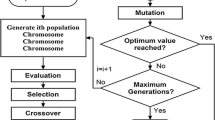Abstract
Despite the ever increasing demand for radio spectrum we are not able to achieve complete efficiency in utilizing the spectrum. The spectrum itself being restricted can only accommodate limited number of users. Therefore, it is very critical to efficiently utilize it. Cognitive radio is perceived as a crucial mechanism for improving spectral efficiency. In this paper we focus on allocating resources to secondary users (SU) which co-exist with primary user (PU) in orthogonal frequency division multiplexed based cognitive radio network. Simultaneous power and subchannel allocation for each SU is considered with the aim to maximize the total throughput or capacity of the system. We also aim to maximize the power efficiency of system and simultaneously keeping a check on total interference caused to PUs. The flexible rate demand for each SU is considered and hence categorized as real time and non real time secondary users. The problem is solved using non-dominant sorting genetic algorithm version II. The results procured are compared with existing solution and optimal solution.











Similar content being viewed by others
References
Staple, G., & Werbach, K. (2004). The end of spectrum scarcity. IEEE Spectrum, 41(3), 48–52. doi:10.1109/MSPEC.2004.1270548.
Federal Communications Commission. (2002). Spectrum policy task force. Rep. ET Docket no. 02-135.
Haykin, S. (2005). Cognitive radio: brain-empowered wireless communications. IEEE Journal on Selected Areas in Communications, 23(2), 201–220. doi:10.1109/JSAC.2004.839380.
Mitola III, J, & Maguire, G. Q, Jr. (1999). Cognitive radio: making software radios more personal. IEEE Personal Communications Magazine, 6, 1318. doi:10.1109/98.788210.
Srinivasa, S., & Jafar, S. A. (2007). Cognitive radios for dynamic spectrum access: The throughput potential of cognitive radio—a theoretical perspective. IEEE Communications Magazine, 45, 7379. doi:10.1109/MCOM.2007.358852.
Sadr, S., Anpalagan, A., & Raahemifar, K. (2009). Radio resource allocation algorithms for the downlink of multiuser OFDM communication systems. IEEE Communications Surveys and Tutorials, 11(3), 92–106. doi:10.1109/SURV.2009.090307.
Pao, W.-C., & Chen, Y.-F. (2014). Adaptive gradient-based methods for adaptive power allocation in OFDM-based cognitive radio networks. IEEE Transactions on Vehicular Technology, 63(2), 836–848. doi:10.1109/TVT.2013.2272804.
Chen, Y., Lei, Q., & Yuan, X. (2014). Resource allocation based on dynamic hybrid overlay/underlay for heterogeneous services of cognitive radio networks. Wireless Personal Communications. doi:10.1007/s11277-014-1950-5.
Mazloumi, L. (2015). K. Shahtalebi1 and M. F. Sabahi, A simple method for throughput maximization of ofdma based CR networks. Wireless Personal Communications. doi:10.1007/s11277-015-2875-3.
Jang, J., & Lee, K. B. (2003). Transmit power adaptation for multiuser OFDM systems. IEEE Journal on Selected Areas in Communications, 21(2), 171–178. doi:10.1109/JSAC.2002.807348.
Rhee, W., & Cioffi, J. M. (2000). Increase in capacity of multiuser OFDM system using dynamic subchannel allocation. In Proceedings of IEEE VTC (Vol. 2, pp. 1085–1089). doi:10.1109/VETECS.2000.851292.
Senthuran, S., Anpalagan, A., & Das, O. (2012). Throughput analysis of opportunistic access strategies in hybrid underlay-overlay cognitive radio networks. IEEE Transaction on Wireless Communications, 11(6), 2024–2035. doi:10.1109/TWC.2012.032712.101209.
Goldsmith, A. J., & Chua, S.-G. (1997). Variable-rate variable-power MQAM for fading channels. IEEE Transaction on Communication, 45(10), 1218–1230. doi:10.1109/26.634685.
Chamber, L. (Ed.). (1995). Practical handbook of genetic algorithms (Vol. 1). Boca Raton: CRC Press.
Srinivas, N., & Deb, K. (1995). Multi-objective function optimization using non dominated sorting genetic algorithms. Evolutionary Computation, 2, 221–248.
Deb, K., Pratap, A., Agarwal, S., & Meyarivan, T. (2002). A fast and elitist multiobjective genetic algorithm: NSGA-II. IEEE Transcations on Evolutionary Computations, 6(2), 182–197. doi:10.1109/4235.996017.
Reddy, Y. B., & Gajendar, N. (2007). Computationally efficient resource allocation in OFDM systems. In Genetic algorithm approach, in proceedings of 4th international conference on information technology new generations (ITNG 2007) (pp. 36–41). doi:10.1109/4235.996017.
Sharma, N., & Anupama, K. R. (2011). On the use of NSGA-II for multiobjective resource allocation in MIMO–OFDMA systems. Wireless Networks, 17, 1191–1201.
Ge, M., & Wang, S. (2012). Fast optimal resource allocation is possible for multiuser OFDM-based cognitive radio networks with heterogeneous services. IEEE Transactions on wireless communication. doi:10.1109/TWC.2012.021512.111233.
Author information
Authors and Affiliations
Corresponding author
Rights and permissions
About this article
Cite this article
Sharma, N., Badheka, D. & Anpalagan, A. Simultaneous Power and Subchannel Allocation in Interference Limited OFDM-Based Cognitive Radio Network with Quality of Service Considerations. Wireless Pers Commun 96, 1691–1710 (2017). https://doi.org/10.1007/s11277-017-4263-7
Published:
Issue Date:
DOI: https://doi.org/10.1007/s11277-017-4263-7




